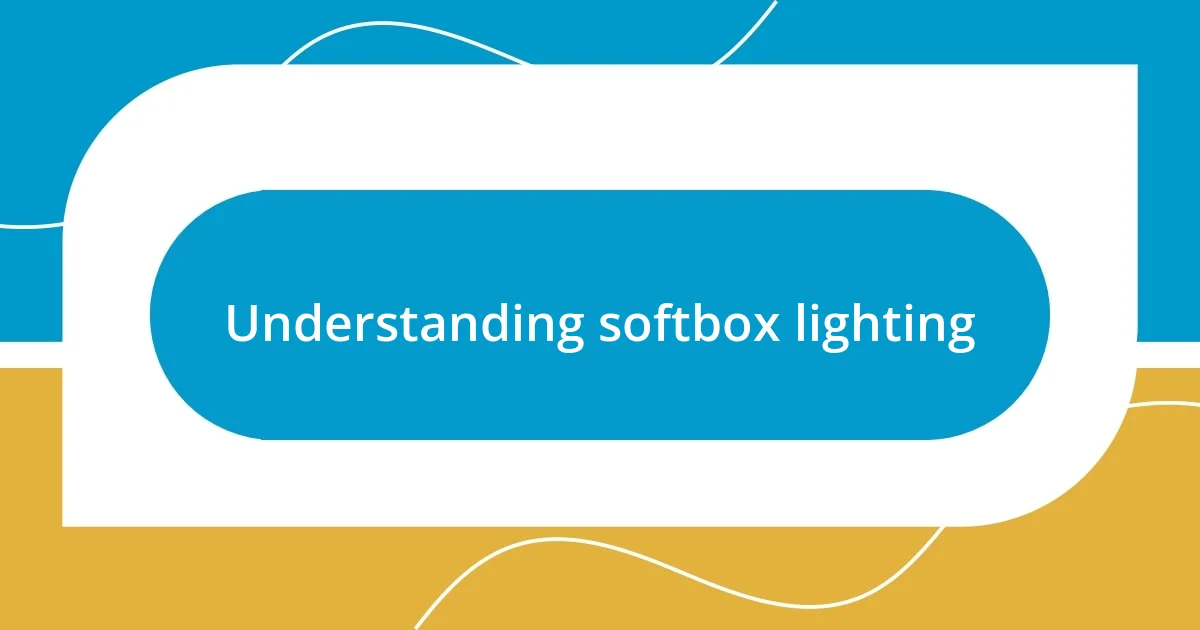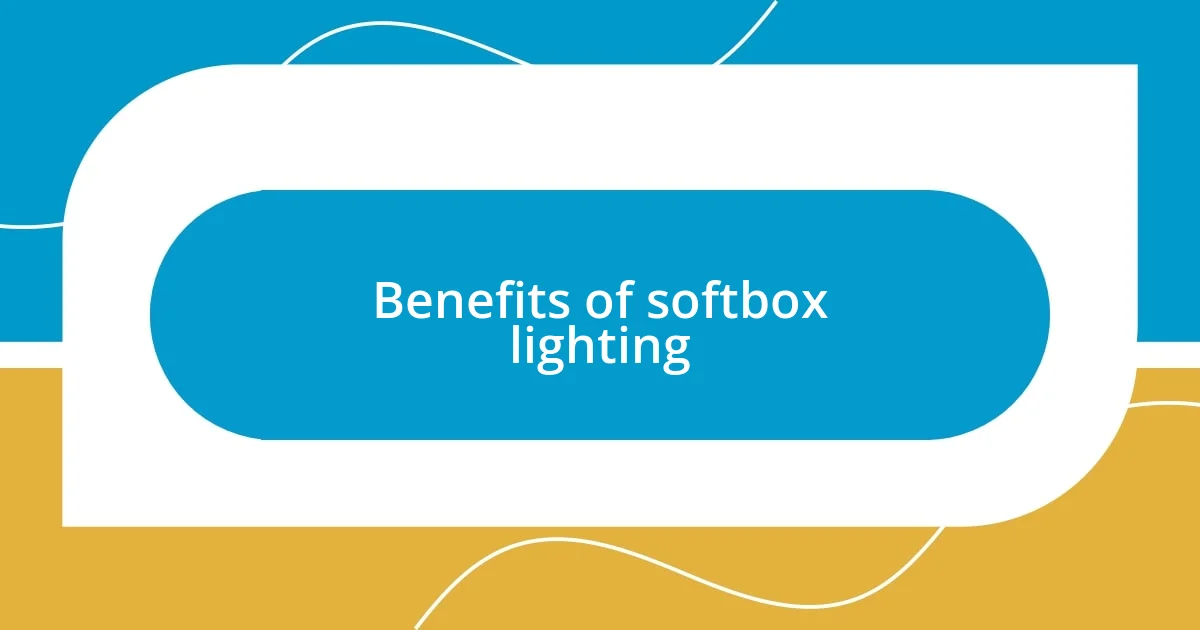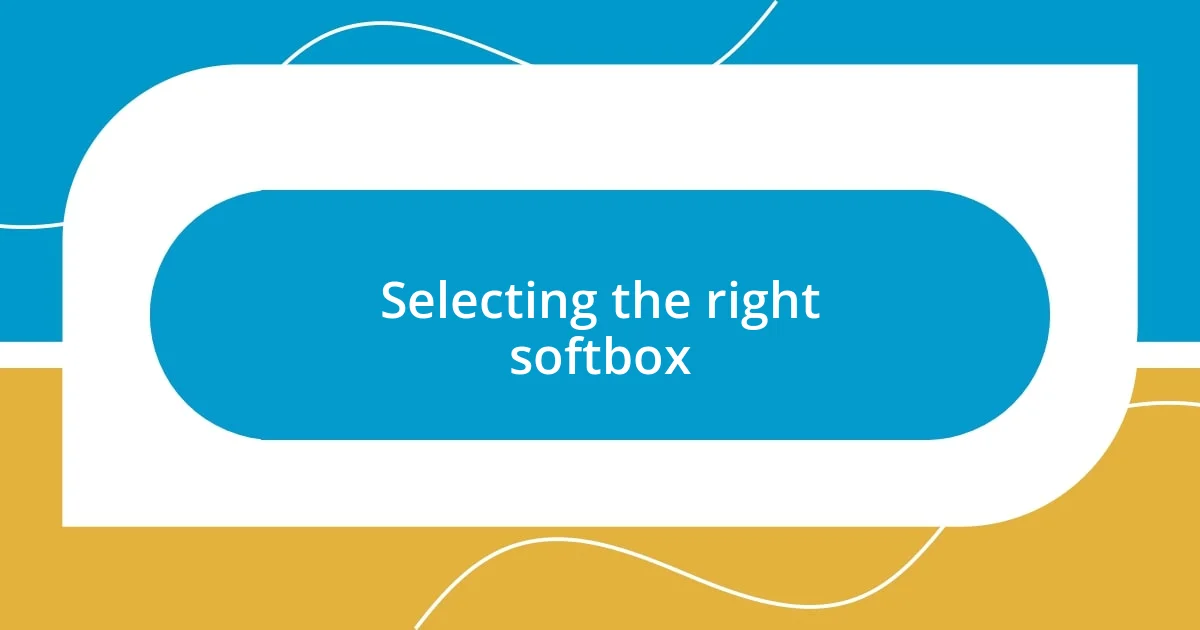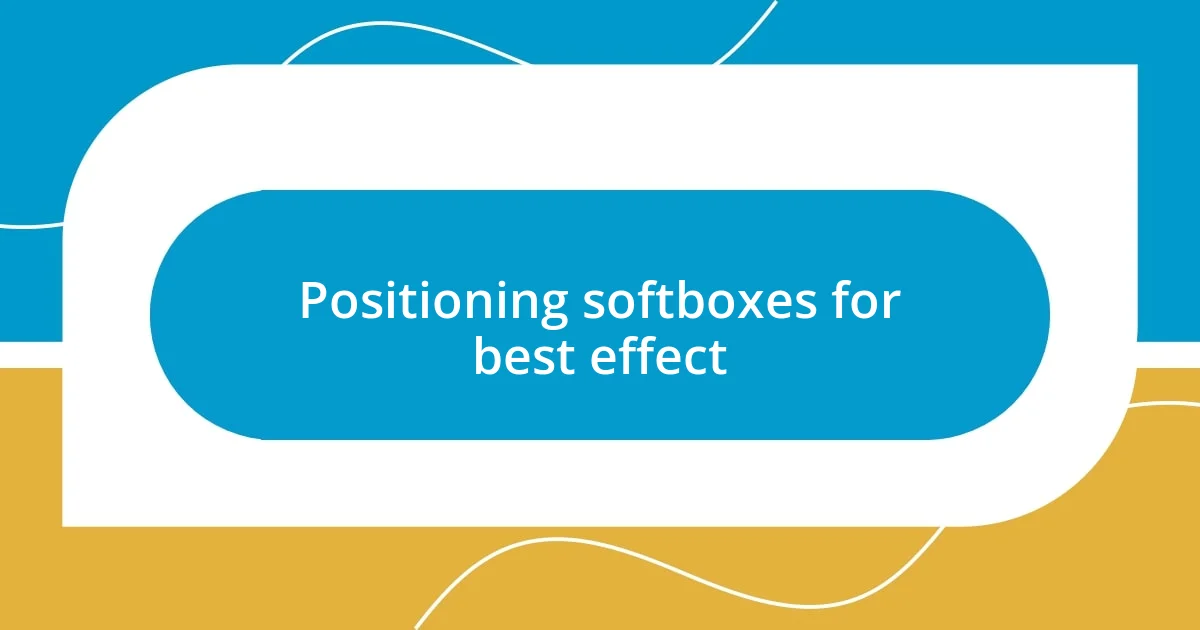Key takeaways:
- Softbox lighting enhances photography by providing soft, diffused light that minimizes harsh shadows and improves subject appearance.
- Choosing the right softbox size and material is essential for achieving desired lighting effects, depending on the type of photography (e.g., portraits vs. products).
- Positioning and adjusting the softbox can dramatically impact the light quality and emotional connection in images, making experimentation crucial for creativity.

Understanding softbox lighting
When I first encountered softbox lighting, I was struck by its ability to transform an ordinary space into a well-lit studio almost instantly. The soft, diffused light it produces not only reduces harsh shadows but also enhances skin tones beautifully, making subjects appear more vibrant and alive. I often wonder how my early photographs might have improved had I discovered this gem sooner.
Setting up a softbox can feel a bit daunting at first, but I’ve learned that it’s all about finding the right position and angle. For example, having the softbox at a 45-degree angle to your subject can create a flattering, three-dimensional effect. There’s something incredibly satisfying about adjusting the light and seeing the immediate impact on your shot—it’s that rush of creativity that keeps me excited about photography.
Every time I use a softbox, I recall a specific shoot where it was a game changer for me. I had a client who was a little nervous about being photographed, and once I adjusted the softbox to provide that gentle, wrap-around light, her confidence visibly soared. Seeing the transformation in her demeanor made me appreciate not just the technical aspect of softboxes, but also the emotional connection they can foster in a creative setting. Isn’t it fascinating how light can influence not just an image, but the mood of the moment itself?

Benefits of softbox lighting
Softbox lighting truly brings a magic touch to photography, and I’ve experienced some real benefits firsthand. One of the most significant advantages is the control it provides over the quality of light. I remember setting up for a portrait shoot outdoors during golden hour. Even though sunlight can be beautiful, it often creates uneven lighting. My softbox allowed me to diffuse that bright sunlight, creating a warm and inviting atmosphere that made my subject feel at ease.
Here are some key benefits of softbox lighting:
- Soft and even light: Minimizes harsh shadows, perfect for portraits and product photography.
- Versatility: Suitable for various settings—portrait, fashion, and even video shoots.
- Ease of use: Simple setup that lets you focus more on creativity than technical fuss.
- Enhanced subject appearance: Improves skin tones and highlights details beautifully.
- Control over light direction: Allows you to shape shadows and highlights to your preference.
When I think back to a recent event I covered, softbox lighting played a pivotal role in elevating the overall quality of the images. I had the chance to photograph a wedding, and the softbox helped to create a dreamy ambiance during the couple’s first dance. The way the light softly wrapped around them truly captured the moment’s emotion, making the images feel more intimate and romantic. There’s just something about how softboxes can transform a scene, and I can confidently say that investing in this lighting setup was one of the best decisions I made as a photographer.

Selecting the right softbox
Selecting the right softbox can truly make a difference in your photography experience. From my own journey, I’ve found that choosing the right size and shape is key. For instance, a larger softbox tends to provide softer light, which is fantastic for portrait shots, while a smaller one might be better suited for product photography where controlled lighting is essential. I recall a challenging shoot where I switched from a small rectangular softbox to a larger octagonal one. The change in the light quality was stunning—it added a beautiful, soft glow that really elevated my shots.
There’s also the choice between different materials, like reflective vs. non-reflective. I used to be a bit in the dark about this, pun intended! Reflective materials can intensify the light output, which is beneficial in low-light setups. However, the non-reflective ones diffuse the light better, offering a more natural finish. I remember feeling nervous about an indoor shoot with dim lighting. By opting for a reflective softbox, I managed to illuminate the scene effectively, and the results astounded both me and my client!
In my experience, understanding the light’s position and the softbox’s placement can make all the difference. Experimenting is part of the journey; you’ll find your unique style along the way. For example, I once tried placing a softbox right above a subject, which created a dramatic, moody effect that I absolutely loved. It sparked that creative joy, reinforcing my belief in investing the time to select the right softbox for each project.
| Softbox Size | Best For |
|---|---|
| Small (up to 24 inch) | Product photography, detailed shots |
| Medium (24-36 inch) | Portrait photography, small to medium subjects |
| Large (36 inch and above) | Group portraits, fashion photography, and larger setups |

Setting up softbox lighting
Setting up softbox lighting isn’t just about connecting a few pieces; it’s an experience that enhances the entire shoot. I remember the first time I set up my softbox at home. As I fiddled with the adjustable stand, excitement bubbled within me, knowing how this would change my photography game. I placed it at a 45-degree angle to my subject, and the instant soft glow filled the room was surreal—it felt like I was painting with light.
Positioning is crucial, and I’ve learned that a little adjustment can profoundly affect the outcome. One evening, I experimented by moving my softbox closer to the subject. I was amazed how it wrapped around them, creating a beautiful halo effect that highlighted every detail. Have you ever seen the magic that happens when light dances just right on a person’s face? It’s like uncovering a hidden layer of emotion—each photo becoming a story.
Don’t forget about the height of your softbox! On one particularly memorable shoot, I raised the softbox a couple of feet higher than usual. The resulting light was breathtaking, casting a gentle shadow that added depth and dimension to the portrait. It struck me how vital it is to be both an artist and a technician in these moments. The joy of discovery, realizing what a simple setup adjustment can achieve, keeps me continually motivated in my photography journey.

Positioning softboxes for best effect
Positioning your softbox can truly elevate your lighting game, and I can’t stress enough how important angles can be. I recall a shoot where I had my softbox facing directly at my subject. At first, the results were decent, but something just felt off. After a bit of experimenting, I tilted it to the side, and the transformation was incredible! The light became more flattering, adding dimension that turned an ordinary shot into something special.
Another aspect that plays a key role is the distance from your subject. I learned this the hard way during a family portrait session. I had my softbox too far away, and the light fell flat. When I brought it in closer, it felt like magic! Suddenly, the expressions were warmer, and the shadows became soft and inviting. Have you ever tried moving your light a few inches and witnessed how it impacts your subject’s mood in the frame? It’s like discovering a new layer of emotional connection that can enrich your storytelling.
Then there’s the height component, which can’t be overlooked. One time, I decided to set my softbox high above my subject’s head, letting the light pour down. The dramatic effect it created was striking; shadows elongated elegantly, adding such a cinematic quality to the portraits. I’ve learned that finding that sweet spot for height often requires a bit of trial and error, but trust me—it’s worth the rewards when that perfect shot unfolds before your eyes. Adjusting your softbox’s position isn’t just technical; it’s an art, and every photographer can paint their own masterpiece!

Adjusting light intensity and diffusion
Finding the right intensity and diffusion in softbox lighting has been a game-changer for my photography. I often start by adjusting the power of my light source; dimming it just a bit can soften the harshness that sometimes creeps in. It reminds me of the first time I dialed back the intensity for a beauty shoot. The skin tones bloomed beautifully, and I couldn’t help but marvel at how subtle changes can completely transform the narrative of a photo.
Diffusion is another critical element that can’t be ignored. I once used a different diffusion fabric for a family portrait session, thinking it wouldn’t make that much of a difference. But wow, was I wrong! The softer light wrapped around the subjects, creating a warm, inviting atmosphere that reflected the bond they shared. Have you ever noticed how the right diffusion can turn a simple portrait into a moment that feels alive? It’s those small details that elevate the entire story you’re trying to tell.
I sometimes find myself experimenting with various diffusion methods, like using a white umbrella in front of my softbox for an even gentler effect. The first time I tried this method, I felt like I was tapping into a whole new world of creativity. The results were stunning, turning ordinary backgrounds into dreamy backdrops. It truly opened my eyes to how light intensity and diffusion can shape the mood of an image, often leading to unexpected and delightful surprises. What’s your favorite way to play around with light?














